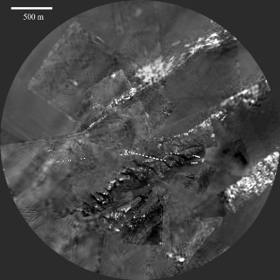Science highlights from Huygens:
#2. Superrotating winds
By measuring the Doppler shift of the radio signal from Huygens and studying panoramic mosaics from the onboard imager to work out the descent trajectory, it was possible to create a high resolution vertical profile of Titan's winds, with an estimated accuracy of better than 1 m/s.
Huygens found that the zonal winds were prograde (the same direction as the Moon's rotation) during most of the atmospheric descent. The probe generally drifted east, driven by remarkably strong westerly winds which peaked at roughly 120 m/s (430 km/h) at an altitude of about 120 km.
 |
| The ground track of Huygens is marked on this aerial view of Titan. Credit: ESA/NASA/JPL/University of Arizona |
Down to a height of 60 km, large variations in the Doppler measurements were observed – evidence that Huygens endured a rough ride as the result of significant vertical wind shear. Wind speeds then decreased toward the surface, dropping from 30 m/s (108 km/h) at an altitude of 55 km to 10 m/s
The large prograde wind speeds measured between 45 km and 70 km altitude and above 85 km were much faster than Titan’s equatorial rotation speed. It was the first in situ confirmation of the predicted superrotation of the moon’s atmosphere, even though the speed observed was slightly lower than expected.
A layer with surprisingly slow wind, where the sideways velocity decreased to near zero, was detected at altitudes between 60 km and 100 km.
During the last 15 minutes of the descent, Huygens headed west-northwest at a speed of approximately 1 m/s. The wind speed on the surface was between 0.3 m/s and 1 m/s.
Over the duration of the descent, the probe drifted eastward a distance of 165.8 km with respect to the surface of Titan.




